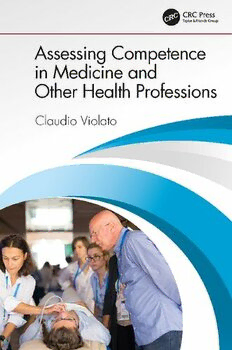
Assessing competence in medicine and other health professions PDF
Preview Assessing competence in medicine and other health professions
Assessing Competence in Medicine and Other Health Professions Assessing Competence in Medicine and Other Health Professions Claudio Violato Professor and Assistant Dean University of Minnesota Medical School CRC Press Taylor & Francis Group 6000 Broken Sound Parkway NW, Suite 300 Boca Raton, FL 33487-2742 © 2019 by Taylor & Francis Group, LLC CRC Press is an imprint of Taylor & Francis Group, an Informa business No claim to original U.S. Government works Printed on acid-free paper International Standard Book Number-13: 978-1-138-59634-4 (Hardback) International Standard Book Number-13: 978-1-4987-8508-2 (Paperback) This book contains information obtained from authentic and highly regarded sources. Reasonable efforts have been made to publish reliable data and information, but the author and publisher cannot assume responsibility for the validity of all materials or the consequences of their use. The authors and publishers have attempted to trace the copyright holders of all m aterial reproduced in this publication and apologize to copyright holders if permission to publish in this form has not been obtained. If any copyright material has not been acknowledged please write and let us know so we may rectify in any future reprint. Except as permitted under U.S. Copyright Law, no part of this book may be reprinted, repro- duced, transmitted, or utilized in any form by any electronic, mechanical, or other means, now known or hereafter invented, including photocopying, microfilming, and recording, or in any information storage or retrieval system, without written permission from the publishers. For permission to photocopy or use material electronically from this work, please access www.copy- right.com (http://www.copyright.com/) or contact the Copyright Clearance Center, Inc. (CCC), 222 Rosewood Drive, Danvers, MA 01923, 978-750-8400. CCC is a not-for-profit organization that provides licenses and registration for a variety of users. For organizations that have been granted a photocopy license by the CCC, a separate system of payment has been arranged. Trademark Notice: Product or corporate names may be trademarks or registered trademarks, and are used only for identification and explanation without intent to infringe. Library of Congress Cataloging‑in‑Publication Data Names: Violato, Claudio, author. Title: Assessing competence in medicine and other health professions / by Claudio Violato. Description: Boca Raton : Florida : CRC Press, [2019] | Includes bibliographical references and index. Identifiers: LCCN 2018032562 | ISBN 9781138596344 (hardback : alk. paper) | ISBN 9781498785082 (pbk. : alk. paper) | ISBN 9780429426728 (e-book) Subjects: | MESH: Clinical Competence | Professional Competence | Educational Measurement | Formative Feedback. Classification: LCC RA399.A1 | NLM W 21 | DDC 616—dc23 LC record available at https://lccn.loc.gov/2018032562 Visit the Taylor & Francis Web site at http://www.taylorandfrancis.com and the CRC Press Web site at http://www.crcpress.com Dedication LeRoy Douglas Travis (October 14, 1940–August 9, 2017) A dear friend and inspirational teacher Contents Preface ix Author xi SECTION I FOUNDATIONS 1 1 Introduction 3 2 Competence and professionalism in medicine and the health professions 35 3 Statistics and test score interpretation 55 4 Correlational-based methods 83 SECTION II VALIDITY AND RELIABILITY 109 5 Validity I: Logical/Face and content 115 6 Validity II: Correlational-based 139 7 Validity III: Advanced methods for validity 163 8 Reliability I: Classical methods 191 9 Reliability II: Advanced methods 213 SECTION III TEST CONSTRUCTION AND EVALUATION 231 10 Formats of testing for cognition, affect, and psychomotor skills 235 11 Constructing multiple-choice items 257 12 Constructed response items 285 13 Objective structured clinical exams 301 14 Checklists, rating scales, rubrics, and questionnaires 319 15 Evaluating tests and assessments: Item analyses 341 16 Grading, reporting, and standard setting 365 Glossary of Terms 395 Index 409 vii Preface Assessing competence in medicine and other health professions continues to be a challenge. The assessment and evaluation of competence and learning have their origins in antiquity but are only now beginning to emerge as a unified field. This is due to developments in statistical and mathematical theory, test theory, and advances in computer hardware and software, as well as the developing internet. Testing and assessment are the acts of quantifying an educational or psychologi- cal dimension or assigning a numerical value to it. Evaluation requires a value judgment to be made based on the measurement. While the history of testing dates back two millennia, it has emerged on a large scale only in the 20th century, coincidental with mass education. The current status of testing is paradoxical: it is on the increase and receives overwhelming public support, and yet most teachers, instructors, and professors (who construct, administer, and interpret the vast majority of tests) have little or no formal education in testing. Tests can be used to motivate students, enhance learning, provide feedback, evaluate educational programs, and for research. Other functions include curriculum revisions, selection and screening, certifica- tion, and guidance and counselling. Tests can be used in a variety of ways and for several evaluation functions. Testing is likely to expand in modern society. The improvement of healthcare professional competence depends, in part, on the improvement of testing and assessment of medical competence. The alarming rate of medical errors that currently result in death or negative outcomes may be reduced. My purpose in writing this book is to provide a resource for teachers, a ssessors, administrators, pedagogues, generally, and students in health professions educa- tion for understanding, implementing, and critically evaluating testing, assess- ment, and evaluation. This is a comprehensive book on how to assess competence in medicine, medical education, and healthcare throughout the clinician’s career. It is organized into three main sections: (1) Foundations, (2) Validity and reli- ability, and (3) Test construction and evaluation consisting of 16 chapters. Each chapter begins with an advanced organizer and contains summaries, reflections, and exercises. The book also contains a glossary of testing and statistical terms—e.g., reliability, validity, standard error of measurement, biserial correlation, ix
